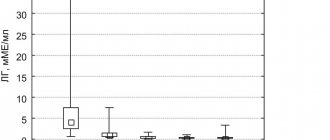Metformin Long Canon long-acting tab 500mg No. 60
Compound
Active substance: metformin hydrochloride 500 mg.
Excipients: hypromellose 2208 (hydroxypropyl methylcellulose 2208) 155 mg; hypromellose 2910 (hydroxypropyl methylcellulose 2910) 4.3 mg; colloidal silicon dioxide 7.6 mg; magnesium stearate 7 mg; microcrystalline cellulose 26.1 mg.
Pharmacokinetics
Absorption
With a single dose of Metformin Long Canon 500 mg and 750 mg at a dosage of 1500 mg, the average time to reach the maximum concentration of metformin in the blood plasma (TCmax) is 5 hours (range 4-12 hours). The average time to achieve the maximum concentration of metformin (1214 ng /ml) in blood plasma (TCmax) after a meal is 5 hours (range 4-10 hours) after a single oral dose of 1 tablet of Metformin Long Canon in the dosage form of a tablet with prolonged release of 1000 mg.
At steady state, identical to the equilibrium state of metformin with regular release, the maximum concentration (Cmax) and the area under the curve “conSpecial instructions”);
With caution:
Use Metformin Long Canon:
- in patients over 60 years of age who perform heavy physical work, which is associated with an increased risk of developing lactic acidosis;
- during breastfeeding;
- in patients with renal failure (creatinine clearance 45-59 ml/min).
Directions for use and doses
Inside.
The tablets are swallowed whole, without chewing, with a sufficient amount of liquid, 1 time per day during or after dinner. The dose of Metformin Long Canon is selected by the doctor individually for each patient, based on the results of measuring blood glucose concentrations. Monotherapy and combination therapy in combination with other hypoglycemic agents
- For patients not taking metformin, the recommended starting dose of Metformin Long Canon is 500 mg or 750 mg once a day, during or after dinner. Every 10-15 days it is recommended to adjust the dose based on the results of measuring the concentration of glucose in the blood plasma. Slowly increasing the dose promotes better gastrointestinal tolerability.
- In case of switching from another hypoglycemic agent, the dose selection of Metformin Long Canon is carried out as described above, starting with the prescription of Metformin Long Canon 500 mg or 750 mg, with a possible subsequent transition to Metformin Long Canon 1000 mg.
- Metformin Long Canon 1000 mg should be taken once a day during or after dinner.
- Metformin Long Canon is prescribed as maintenance therapy to patients taking metformin in the form of regular-release tablets at a dose of 1000 mg and 2000 mg. To switch to Metformin Long Canon 1000 mg, the daily dose must be equivalent to the daily dose of metformin with regular release.
- Patients taking metformin in the form of regular-release tablets at a dose exceeding 2000 mg are not recommended to switch to Metformin Long Canon.
Combination with insulin
To achieve better glycemic control, metformin and insulin can be used in combination therapy. The usual starting dose of Metformin Long Canon is 1 tablet of 500 mg or 750 mg once a day with dinner, while the dose of insulin is selected based on the results of measuring blood glucose concentrations. Then it is possible to switch to Metformin Long Canon 1000 mg.
Daily dose
The maximum recommended dose of Metformin Long Canon is 2000 mg. If adequate glycemic control is not achieved when taking the maximum recommended dose once daily, the maximum dose may be divided into two doses: one 1000 mg tablet with breakfast and one 1000 mg tablet with dinner. If adequate control of hypoglycemia is not achieved in this case, a switch to regular-release metformin with a maximum daily dose of 3000 mg is possible.
Patients with kidney failure
Metformin Long Canon can be used in patients with moderate renal failure (creatinine clearance 45-59 ml/min) only in the absence of conditions that may increase the risk of developing lactic acidosis.
The initial dose is 500 mg or 750 mg once daily. The maximum dose is 1000 mg per day. Renal function should be carefully monitored every 3-6 months. If creatinine clearance is below 45 ml/min, the drug should be discontinued immediately.
Elderly patients
In elderly patients, the dose of metformin is adjusted based on an assessment of renal function, which should be carried out regularly (see "Special Instructions").
Duration of treatment
Metformin Long Canon should be taken daily, without interruption. If treatment is stopped, the patient must inform the doctor.
Missing a dose
If you miss a regular dose, take the next dose at the usual time. You should not take a double dose of Metformin Long Canon.
Storage conditions
At a temperature not exceeding 25 °C in the manufacturer's packaging. Keep out of the reach of children.
Best before date
2 years. Do not use after the expiration date.
special instructions
Lactic acidosis
Lactic acidosis is a rare but serious complication (high mortality if not promptly treated) that may occur due to accumulation of metformin. Cases of lactic acidosis when taking metformin occurred mainly in patients with diabetes mellitus with severe renal failure.
Other associated risk factors should be taken into account, such as decompensated diabetes mellitus, ketosis, prolonged fasting, alcoholism, liver failure and any condition associated with severe hypoxia. This may help reduce the incidence of lactic acidosis.
The risk of developing lactic acidosis should be taken into account when nonspecific signs appear, such as muscle cramps accompanied by dyspeptic disorders, abdominal pain, and severe asthenia.
Lactic acidosis is characterized by severe malaise with general weakness, acidotic shortness of breath, vomiting, abdominal pain, muscle cramps and hypothermia followed by coma. Diagnostic laboratory parameters are a decrease in blood pH (less than 7.25), plasma lactate concentration over 5 mmol/l, increased anion gap and lactate/pyruvate ratio. If metabolic acidosis is suspected, stop taking the drug and consult a doctor immediately.
Surgical operations
The use of metformin should be discontinued 48 hours before elective surgery and can be continued no earlier than 48 hours after, provided that renal function has been found to be normal during the examination.
Kidney function
Since metformin is excreted by the kidneys, before starting treatment and regularly thereafter, it is necessary to determine creatinine clearance: at least once a year in patients with normal renal function and 2-4 times a year in elderly patients, as well as in patients with creatinine clearance at lower limit of normal.
Particular caution should be exercised in case of possible impairment of renal function in elderly patients, with simultaneous use of antihypertensive drugs, diuretics or non-steroidal anti-inflammatory drugs.
Heart failure
Patients with heart failure have a higher risk of developing hypoxia and renal failure. Patients with chronic heart failure should have cardiac and renal function monitored regularly while taking metformin. Taking metformin for acute failure and chronic heart failure with unstable hemodynamic parameters is contraindicated.
Other Precautions
Patients are advised to continue to follow a diet with even carbohydrate intake throughout the day. Overweight patients are recommended to continue to follow a hypocaloric diet (but not less than 1000 kcal/day). Patients should also exercise regularly.
Patients should inform their physician about any treatment they are undergoing and any infectious diseases such as colds, respiratory tract infections, or urinary tract infections.
It is recommended that routine laboratory tests be performed regularly to monitor diabetes mellitus.
Metformin does not cause hypoglycemia when used alone, but caution is recommended when used in combination with insulin or other oral hypoglycemic agents (for example, sulfonylureas or repaglinide, etc.). Symptoms of hypoglycemia include weakness, headache, dizziness, increased sweating, rapid heartbeat, blurred vision, or difficulty concentrating.
It is necessary to warn the patient that the inactive components of the drug Metformin Long Canon can be excreted unchanged through the intestines, which does not affect the therapeutic activity of the drug.
Description
Hypoglycemic agent of the biguanide group for oral use.
Pharmacodynamics
Metformin is a biguanide with a hypoglycemic effect, reducing both basal and postprandial plasma glucose levels. It does not stimulate insulin secretion and therefore does not cause hypoglycemia. Increases the sensitivity of peripheral receptors to insulin and the utilization of glucose by cells. Reduces liver glucose production by inhibiting gluconeogenesis and glycogenolysis. Delays the absorption of glucose in the intestine.
Metformin stimulates glycogen synthesis by acting on glycogen synthase. Increases the transport capacity of all types of membrane glucose transporters.
While taking metformin, the patient's body weight either remains stable or decreases moderately.
Metformin has a beneficial effect on lipid metabolism: it reduces the content of total cholesterol, low-density lipoproteins (LDL) and triglycerides.
Side effects
Classification of the frequency of side effects according to the recommendations of the World Health Organization: very often (≥1/10), often (from ≥1/100 to <1/10), infrequently (from ≥1/1000 to <1/100), rarely ( from ≥1/10000 to <1/1000), very rarely (<1/10000), including isolated reports; frequency unknown - based on available data, it is not possible to determine the frequency of occurrence.
Metabolic and nutritional disorders: very rarely: lactic acidosis (See “Special Instructions”).
With long-term use of metformin, a decrease in the absorption of vitamin B)2 may be observed. When megaloblastic anemia is detected, the possibility of such an etiology must be taken into account.
Nervous system disorders: often: taste disturbances (metallic taste in the mouth).
Gastrointestinal disorders: very common: nausea, vomiting, diarrhea, abdominal pain and lack of appetite. Most often they occur during the initial period of treatment and in most cases resolve spontaneously. To prevent symptoms, it is recommended to take Metformin Long Canon during or after meals.
Slowly increasing the dose may improve gastrointestinal tolerability.
Disorders of the liver and biliary tract: very rarely: abnormal liver function tests and hepatitis; after discontinuation of metformin, adverse effects completely disappear.
Skin and subcutaneous tissue disorders: very rare: skin reactions such as erythema (redness of the skin), itching, urticaria.
If any of the side effects indicated in the instructions worsen, or if other side effects not listed in the instructions appear, you should inform your doctor.
Use during pregnancy and breastfeeding
Decompensated diabetes mellitus during pregnancy is associated with an increased risk of birth defects and perinatal mortality.
Limited evidence suggests that taking metformin in pregnant women does not increase the risk of birth defects in their children.
When planning pregnancy, as well as in the event of pregnancy while taking metformin, the drug should be discontinued and insulin therapy should be prescribed. It is necessary to maintain the blood glucose level at a level closest to normal to reduce the risk of fetal defects.
Metformin is excreted in breast milk. No side effects were observed in breastfeeding newborns while taking metformin. However, due to limited data, the use of the drug during breastfeeding is not recommended. The decision to stop breastfeeding should be made taking into account the benefits of breastfeeding and the potential risk of side effects for the baby.
Interaction
Contraindicated combinations
Iodine-containing radiocontrast agents:
against the background of functional renal failure in patients with diabetes, radiological examination using iodine-containing radiocontrast agents can cause the development of lactic acidosis. Treatment with Metformin Long Canon should be discontinued depending on renal function 48 hours before or during an X-ray examination using iodine-containing radiocontrast agents and resumed no earlier than 48 hours after, provided that during the examination renal function was found to be normal.
Not recommended combinations
Alcohol.
With acute alcohol intoxication, the risk of developing lactic acidosis increases, especially in the case of:
— insufficient nutrition, following a low-calorie diet;
- liver failure.
While taking the drug, you should avoid drinking alcohol and medications containing ethanol.
Combinations requiring caution
Medicines with indirect hyperglycemic effect
(eg, corticosteroids (GCs) and tetracosactide (systemic and local), β2-agonists, danazol, chlorpromazine when taken in large doses (100 mg per day) and diuretics): more frequent monitoring of blood glucose concentrations may be required, especially in the beginning of treatment. If necessary, the dose of Metformin Long Canon can be adjusted during treatment and after its cessation, based on the level of glycemia.
Diuretics:
simultaneous use of loop diuretics can lead to the development of lactic acidosis due to possible functional renal failure.
With simultaneous use of the drug Metformin Long Canon with sulfonylurea derivatives, insulin, acarbose, salicylates
hypoglycemia may develop.
Nifedipine
increases absorption and Cmax of metformin.
Cationic drugs
(amiloride, digoxin, morphine, procainamide, quinidine, quinine, ranitidine, triamterene, trimethoprim and vancomycin), secreted in the renal tubules, compete with metformin for tubular transport systems and can lead to an increase in its Cmax.
Kolesevelam
when used simultaneously with metformin in the form of extended-release tablets, it increases the concentration of metformin in the blood plasma (increased AUC without a significant increase in Cmax).
Overdose
When using metformin in a dose of up to 85 g (42.5 times the maximum daily dose), no hypoglycemia was observed. However, in this case, the development of lactic acidosis was observed. Significant overdose or associated risk factors can lead to the development of lactic acidosis (see “Special Instructions”).
Treatment: if signs of lactic acidosis appear, treatment with the drug must be stopped immediately, the patient must be urgently hospitalized and, after determining the lactate concentration, the diagnosis must be clarified. The most effective measure for removing lactate and metformin from the body is hemodialysis. Symptomatic treatment is also carried out.
Impact on the ability to drive vehicles and operate machinery
Monotherapy with Metformin Long Canon, extended-release tablets, does not cause hypoglycemia and therefore does not affect the ability to drive vehicles and machines.
However, it is possible to develop hypoglycemia when using metformin in combination with other hypoglycemic drugs (sulfonylurea derivatives, insulin, repaglinide, etc.). If symptoms of hypoglycemia appear, you should not drive vehicles or machinery.
The problem of insulin resistance in T2DM
The main pathogenetic link of T2DM is the body's resistance to insulin. This means a violation of the biological response of peripheral tissue to the action of insulin, which “works” in both an endogenous and exogenous manner. Now there is such a thing as genetic determination of insulin resistance. For example, patients suffering from T2DM are carriers of point genetic mutations. Places of their origin:
- leptin receptor gene;
- SIR-1 gene (insulin receptor substrate);
- PPAR-gamma.
Secondary insulin resistance is caused by intoxication of the body with glucose, that is, a situation when a person is in a hyperglycemic state that lasts for a long time. Since modern man, unfortunately, consumes much more energy than he spends, it is insulin resistance that takes one of the leading places among the factors due to which:
- abdominal obesity occurs;
- free fatty acids accumulate in the body;
- as a result: a person gets sick with diabetes mellitus-2.
As already noted, the risk of heart and vascular diseases in diabetes is very high, which often leads to premature deaths among such patients.
Questions about the use of the drug for various diseases and conditions
In recent years, clinicians have been talking a lot about the possibilities of using metformin for patients suffering from NAFLD. In addition, it has been successfully prescribed to women with polycystic ovary syndrome for the purpose of ovulation induction. In this case, it is used as an independent remedy or combined with clomiphene.
If we compare the effect of metformin with the effect of other drugs that lower sugar levels, it has a much stronger anti-cancer potential, inhibiting the proliferation of pathological cells that form in the mammary glands in women and in the prostate in men. In order to evaluate this effect of metformin more objectively, further research is necessary.
Clinical symptoms of insulin resistance
Liver tissue, as well as muscle and fat tissue, lose sensitivity to the drug. Myocytes (muscle cells) suffer from a lack of glucose, as there are serious problems with its entry into the muscles from the bloodstream. In turn, adipocytes (fat cells) do not respond to the antilipolytic effect exerted by insulin. As a result, the following accumulate in the body:
- free fatty acids (abbreviated FFA);
- glycerol.
It is due to the action of FFA that low-density atherogenic lipoproteins (or VLDL) are formed.
Due to insulin resistance in the liver tissue, glycogenesis becomes lower, and glycogenolysis and gluconeogenesis, on the contrary, increase, which causes the development of hyperglycemia.






